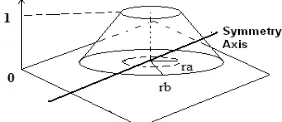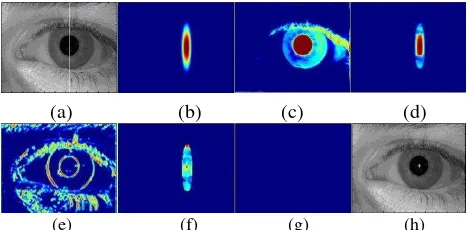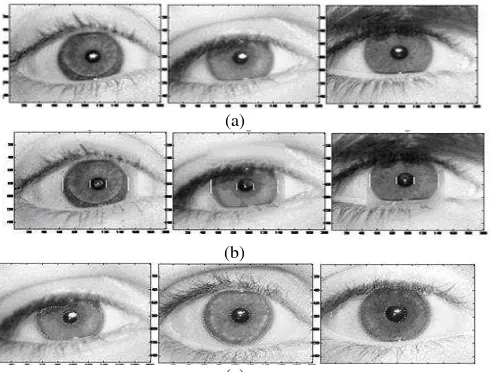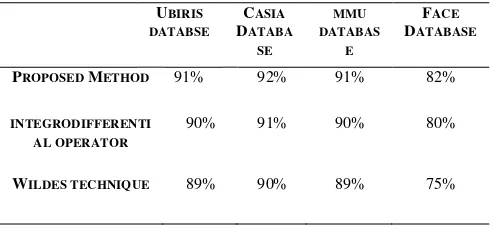69:6 (2014) 73–77 | www jurnalteknologi.utm.my | eISSN 2180–3722 |
Teknologi
Iris Localisation Using Fuzzy Centre Detection (FCD) Scheme and Active
Contour Snake
Masrullizam Mat Ibrahima, John S. Soraghanb, Nurulfajar Abd Manapa*
aFaculty of Electronics and Computer Engineering, Universiti Teknikal Malaysia Melaka, Hang Tuah Jaya,76100 Durian Tunggal, Melaka, Malaysia
bElectronic and Electrical Engineering Department, University of Strathclyde, 204 George Street, Glasgow GI IXW, Scotland, United Kingdom
*Corresponding author: [email protected]
Article history
Received :1 January 2014 Received in revised form : 15 February 2014 Accepted :18 March 2014
Graphical abstract
Abstract
Iris localisation is a crucial operation in iris recognition algorithm and also in applications, where irises are the main target object. This paper presents a new method to localise iris by using Fuzzy Centre Detection (FCD) scheme and active contour Snake. FCD scheme which consists of four fuzzy membership functions is purposely designed to find a centre of the iris. By using the centre of iris as the reference point, an active contour Snake algorithm is employed to localise the inner and outer of iris boundary. This proposed method is tested and validated with two categories of image database; iris databases and face database. For iris database, UBIRIS.v1, UBIRIS.v2, CASIA.v1, CASIA.v2, MMU1 and MMU2 are used. Whilst for face databases, MUCT, AT&T, Georgia Tech and ZJUblink databases are chosen to evaluate the capability of proposed method to deal with the small size of the iris in the image database. Based on the experimental result, the proposed method shows promising results for both types of databases, including comparison with the some existing iris localisation algorithm.
Keywords: Iris localization; fuzzy scheme; active conyour; snake algorithm
© 2014 Penerbit UTM Press. All rights reserved.
1.0 INTRODUCTION
Iris localization is an important operation in iris recognition, and also being used in Human Computer Interaction (HCI) application to track eye gaze, which allows the eyes interact with computer interface [1, 2]. In iris recognition algorithm, the accuracy of iris localise inner and outer boundaries of iris are important in order to obtain the precise characteristics of the individual iris. Failure to locate means the data encode from the pattern on individual iris is insufficient to represent the biometric individual identity. For eye gaze tracking, the center of iris is necessary to detect precisely in which is each of movement, which is measured from the center point. The movements of these points represent communication signals between the eyes and computer interface. Then, the computer system via its interface interprets the eye gaze and takes action on its behavior.
The growing of iris localisation researches has been started since the middle of the 1980s, when iris was identified that able to represent the unique patterns for biometric identification [3]. Flom et al., have patented the automatic iris recognition system which based on edge detection to localise the iris [3]. Subsequently, there were more details researches on iris localise and iris pattern extraction conducted, one of them is Wildes applied gradient edge detection and binary edge map to locate the iris [4]. The radii and centre of iris were discovered then using Hough Transform. An
aggressive research by Dougman in iris recognition has successfully introduced a prominent technique of iris localisation known as integro-differential operator which is used to find the circle of pupil and limbic [5]. After that, several different techniques appeared such as Boles et al. who utilised gray level value on virtual circle in order to get iris diamet, Yong et al. used Canny operator and Hough Transform to locate the iris boundary with an acceptable approximation of iris centre, and Vatsa et al.
detected pupil with employing threshold and Freeman’s Code, and
then the iris was localised by linear contrast filter [6-8].
These aforementioned methods are not considered physiological attributes of the iris region, and there is an additional image processing algorithm needed to rule out any occlusions introduced by eyelids or eyelashes. Hence, Daugman [1] has proposed active contour method that able to segment the occlude region caused by this physiological attributes in iris localisation algorithm. There is another aspect need to be considered in developing a robust iris localisation technique, for instance the movement of eyes, the camera distance, illumination changing and varying focus condition.
has been evaluated to the detection rate using UBIRIS v1, UBIRIS v2, CASIA v1, MMU1 and MMU2 for iris database. Furthermore, AT&T, Georgia Tech and ZJUblink databases are used to examine the detection rate of iris localisation for small of iris image. The remainder of this paper is organised as follows [9-14]. Section 2 describes the pupil centre detection using FCD scheme. Section 3 describes a preprocessing technique for this method. Then, Section 4 presents an active contour Snake to localise iris boundaries while Section 5 presents the experiments result of this proposed method. Section 6 is a conclusion the paper.
2.0 IRIS CENTRE DETECTION USING FUZZY CENTRE DETECTION (FCD) SCHEME
This paper presents a new method for iris localisation, which uses Fuzzy Centre Detection (FCD) to detect the centre of iris, and active contour Snake to detect the boundaries of the iris. There are four fuzzy membership functions are applied in this FCD scheme. In FCD scheme, the vertical axis of symmetry is necessary to be first identified. By considering the geometry characteristic of the iris and pupil which is approximately circle-like, the vertical axis that represents symmetry of the iris and pupil is identified using the sliding window technique.
The sliding window technique is used to find the finest symmetry axis by a pre-defined window that splits into two same sides. Then, the windows are shifted horizontally through the eye region. The both window sides are compared with each other and the lowest score of comparison based on the intensity value is considered as symmetry axis. However, the local minimum score is inconsistent to represent the symmetry axis as shown in Figure 1. The lowest subtraction score is indicated from the left and right of eye region and the absolute symmetry axis is indicated as the steepest subtraction score. In order to meet the accurate Symmetry Axis (SA), the subtraction score (as shown in
Figure 2) is computed in second derivative as follows:
�� = � {��22 ∑ |� , −
�
: |
, − � , +�: − : } (1)
where N is the window size and y is the horizontal position of eye image.
Figure 1 Subtraction scores for two different eyes
FCD consists of four fuzzy membership functions which the first function is an axis proximity function cp of centre point. Based on the obtained axis of symmetry, this function gives a weight to each pixel of the image along the axis of symmetry that defined as follows:
� � , = {
� �
� −�
� −� � < � �
� < �
(2)
Figure 2 Second derivative scores
This function (2) based on iris and pupil characteristic circular–like shape where ra and rb are the threshold radius value. The function is presented as trapezoidal shape (as shown in Figure 3) which the score 1 is given in radius ra along symmetry axis and score 0 for outside rb.
Figure 3 Centre point membership function cp
The following membership function is based on the darkness characteristic of the iris and pupil which is specified as follows:
� = {
� �
− �� � � �
� � (3)
where t1 and t2 in this function represents the threshold grayscale value of pupil and iris, while m is a gradient line of t1 and t2, and b is an intersection of y-axis value (as shown in Figure 4). Based on Bath and UBIRIS V1and UBIRIS V2 database, the acceptable threshold value of t1 and t2 is 70 and 100 respectively. The next membership function FI is an intersection in between function μcp and function μd. This function has significantly reduced the set of pixels of centre points candidate which computed as follows:
��� , = min �� , , � , (4)
The final fuzzy membership function of FCD is the radial searching over a specific range from the remaining centre point candidate region into the binary edges map of pupil that generated from Sobel edge detection as shown in
Figure 5. The ranges circular search in circular path is from 3300 to 300 and 1500 to 2100 with respect to the horizontal axis as reference 00. These ranges represent the exact edges of pupil compared to others degree ranges that normally corrupted by eyelids and eyelashes.
Figure 5 Searching area for function μce
The lengths from a point of the remaining candidate centre region to the edge within the circular target range are measured and accumulated. Each of the summed lengths result is normalised by dividing into maximum length and it is represented as μce. This calculation is performed at every point in the remaining candidate region. The final decision of iris centre function is an intersection in between function μFI and μce which computedas follows.
��� , = min � , , ��� , (5)
The whole FCD scheme stages result of detecting the centre of the iris is illustrated in Figure 6.
(a) (b) (c) (d)
(e) (f) (g) (h)
Figure 6 Fuzzy Centre Detection (FCD) scheme result. (a) Symmetry axis detection, (b) cp, (c) d, (d) FI, (e) binary edge map, (f) μce, (g) FD and (h) centre iris detection
3.0 PRE-PROCESSING
In normal eye image, there is a bright spot that located in a region of pupil, which is captured by the light reflection. This spot affects the performance of sliding window operation and FCD scheme detection. In order to eliminate this typical spot without affect the surrounding regions form, the exact location of spot is necessary firstly located. By employing the threshold value as mentioned, the location of bright spot is detected [15]. To remove this spot, the neighbour equality value adaption technique is applied. This technique allows the mean intensity from the
neighbours’ pixel of bright spot is used to replace the bright spot intensity values and the result as in Figure 6.
(a) (b) (c) (d)
Figure 7 Bright spot reduction. (a) and (c) iris images that has bright spot. (b) and (d) iris images after bright spot reduction process
4.0 BOUNDARIES DETECTION USING ACTIVE CONTOUR SNAKE
Active contour Snake is an optimization technique which aims to find a contour of object in image. In this case, snake is employed to discover the boundary of outer iris and inner iris. A snake has parameters to enable the contour to search the edges through stretch and bend within the target object. The Snake evolution process involves expressing the parameters in the form of an energy function as presented in equation as follows:
stretch and bend, and Eimage shows the energy that relate to edge of image. The internal snake energy can be further describe as edge energy that requires being at minimum for points on a strong edge detected and maximum in no edge region detected. Eedges is computed as follows: minimum of edges intensities respectively.(a) (b)
Figure 8 Initial point of Snake. (a) Number of edges discovered during FCD scheme. (b) Initial snake contour for inner and outer iris boundaries
Instead of the ability of adequately detected boundary, the classical Snake have a problem when the absence of edge points that tend to evolve into a point mass or straight line. Therefore, an improved optimization technique of Snake proposed in [16] is employed in order to remedy the abovementioned problem. This technique involves internal and external force of snake. The internal force of Snake tend to collapse into straight line because the second derivative term in internal snake energy (7) is minimised and approximately to zero. For iris segmentation, the best approach to avoid this problem is the circular initial contour held its shape in the absence of the other force. Due to the second derivative to maintain the continuity, in order to ensure circle of shape have constant curvature the third derivative replace the second derivative.
The external force relate to edge energy Eedges maintain in same force in classic Snake. However in this technique, two additional external forces are added up that required for the Snake to expand toward its final location. Consequently, an expansion or balloon force is introduced. The balloon force EBalloon is calculated by approximating the tangent to the snake contour and rotating the tangent by 90 degrees such that an outward pointing normal of the contour is obtained. A directional vector between a snake point and each of 8 neighbours is generated as shown in
Figure 9. The neighbour with the greatest projection designates the direction in which the Snake point move next. The projection output are normalised and remapped so that the lowest cost corresponds to the greatest projection score is a similar to Equation (9).
(a) (b)
Figure 9 (a) Vector direction. (b) A Snake point and its 8 neighbours with corresponding directional vector
5.0 EXPERIMENTAL RESULTS
In order to evaluate the performance of the proposed method, extensive experiments have been performed. These experiments focused on evaluating the performance of FCD scheme, performance of active contour Snake for detecting the boundaries of the iris, and the overall performance of the proposed iris localisation method. For all experiments, there were four set data had been used as described earlier; UBIRIS iris database, MMU
iris database, CASIA iris database, and face images database. Figure 10 shows some images of iris localisation results, where Figure 10(b) results of bright spot elimination, and Figure 10(c) for iris boundaries detection results.
(a)
(b)
(c)
Figure 10 Iris localisation results. (a) Input iris images (b) Bright spot elimination images. (c) Iris boundaries detection images
5.1 Centre of Iris Detection Using FCD
To evaluate the ability to detect centre of iris, there were 100 samples randomly chosen from each of database as listed in Table 1. The overall performance as indicated in Table 1 in which the highest detection rate is 95%, and the lowest rate is from face images database.
Table 1 Centre of iris detection results
UBIRIS DATABASE
MMU DATABASE
CASIA
DATABASE
FACE
DATABASE
DETECTION
RATE
95% 95% 92% 86%
5.2 Iris Boundaries Detection Using Active Contour Snake
In the experiment to evaluate the performance of active contour snake, there were 100 images of each database were employed. For this experiment, the centres of the iris for all images were initially annotated manually. From that point, the active contour Snake starts searching the boundaries of the iris. Table 2 shows the performance results of experiment.
Table 2 Iris boundaries detection results
UBIRIS DATABASE
MMU DATABASE
CASIA
DATABASE
FACE
DATABASE
DETECTION
RATE
92% 93% 92% 84%
5.3 Iris Localisation
compared with another two methods, known as integrodifferential operator [5] and Wildes technique [4]. There were another 100 different images of each database were used to evaluate the performance, which indicate that the proposed method obtained the best result compared to another two methods.
Table 3 Iris localisation results
UBIRIS DATABSE
CASIA
DATABA SE
MMU DATABAS
E
FACE
DATABASE
PROPOSED METHOD 91% 92% 91% 82%
INTEGRODIFFERENTI AL OPERATOR
90% 91% 90% 80%
WILDES TECHNIQUE 89% 90% 89% 75%
5.0 CONCLUSION
A new method for accurate iris region localisation was presented. This method is a combination of Fuzzy Centre Detection (FCD) scheme and active contour Snake algorithm. FCD scheme is to locate the centre point of iris, while active contour Snake search the boundaries of iris from the located centre point. The proposed method is sensitive to bright spot bright spot that located in a region of pupil caused by reflection of light. Therefore, pre-processing is carried out which uses a threshold technique to eliminate the bright spot. The active contour Snake that applied in this method employs optimization technique in order to remedy the tendency of Snake to evolve into a point mass or straight line problem. Based on the experimental results, the FCD scheme indicates acceptable result to locate the centre of the iris and active contour Snake able to detect the boundaries of the iris. In addition,the result obtained for the whole iris location method with this approach provides better results in comparison to other two algorithms. Based on the database that is used in the experiment, the face database shown the less detection rate because of the iris is smaller.
Acknowledgement
The authors would like to thank Ministry of Higher Education, Malaysia and Universiti Teknikal Malaysia Melaka (UTeM) for PhD Study Scholarship for funding this research activity.
References
[1] J. Daugman. 2007. New Methods in Iris Recognition. Systems, Man, and Cybernetics, Part B: Cybernetics, IEEE Transactions on. 37: 1167–1175. [2] P. Biswas and P. Langdon. 2011. A New Input System for Disabled Users Involving Eye Gaze Tracker and Scanning Interface. Journal of Assistive Technologies. 5: 9.
[3] F. Leonard and S. Aran. 1987. Iris Recognition System.
[4] R. P. Wildes. 1997. Iris Recognition: An Emerging Biometric Technology. Proceedings of the IEEE. 85: 1348–1363.
[5] J. Daugman. 2004. How Iris Recognition Works. Circuits and Systems for Video Technology, IEEE Transactions on. 14: 21–30.
[6] W. W. Boles and B. Boashash. 1998. A Human Identification Technique Using Images of the Iris and Wavelet Transform. Signal Processing, IEEE Transactions on. 46: 1185–1188.
[7] Z. Yong, T. Tieniu, and W. Yunhong. 2000. Biometric Personal Identification Based on Iris Patterns. In Pattern Recognition, 2000. Proceedings. 15th International Conference on. 2: 801–804.
[8] M. Vatsa, R. Singh, and A. Noore. 2006. Reducing the False Rejection Rate of Iris Recognition Using Textural and Topological Features. International Journal of Information and Communication Engineering. 2: 7.
[9] H. Proenca, S. Filipe, R. Santos, J. Oliveira, and L. A. Alexandre. 2010. The UBIRIS.v2: A Database of Visible Wavelength Iris Images Captured On-the-Move and At-a-Distance. Pattern Analysis and Machine Intelligence, IEEE Transactions on. 32: 1529–1535.
[10] C. A. o. S. (CASIA). Biometrics Idea Test. Available: http://www.idealtest.org/findTotalDbByMode.do?mode=Iris.
[11] M. U. (MMU). (November 2011). iris image database (2005). Available: http://pesona.mmu.edu.my/ccteo.
[12] F. S. Samaria and A. C. Harter. 1994. Parameterisation of a Stochastic Model for Human Face Identification. In Applications of Computer Vision, 1994., Proceedings of the Second IEEE Workshop on. 138–142. [13] A. V. Nefian. Georgia Face Database [Online]. Available:
http://www.anefian.com/research/face_reco.htm.
[14] P. Gang, S. Lin, W. Zhaohui, and L. Shihong. 2007. Eyeblink-based Anti-Spoofing in Face Recognition from a Generic Webcamera. In Computer Vision, 2007. ICCV 2007. IEEE 11th International Conference on. 1–8.
[15] W. K. Kong and D. Zhang. 2001. Accurate Iris Segmentation Based on Novel Reflection and Eyelash Detection Model. In Intelligent Multimedia, Video and Speech Processing, 2001. Proceedings of 2001 International Symposium on. 263–266.



